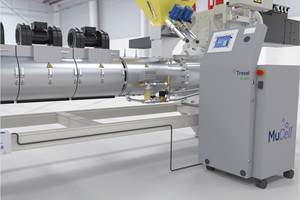New Surfing Fin Made With Recycled WPC
Future Fins, Green Dot collaborate on fin for stand-up paddleboards.
, a Huntington Beach, Calif. designer and manufacturer of gear for surfing, has collaborated with to produce an environmentally friendly fin for stand-up paddleboards. The fin is made from a wood-plastic composite, utilizing reclaimed wood and recycled plastics. Called Keel, the fin reportedly meets, and in some aspects exceeds, traditional performance demands.
Futures Fins came to Green Dot looking for an environmentally friendly material with the natural aesthetics of wood that would also meet the performance requirements of the engineering-grade plastics normally used for this application. One of Green Dot’s Terratek wood-plastic composites, a blend of reclaimed wood fibers with recycled plastic, turned out to be the right solution.
Futures Fins’ mission is to market products as the ultimate in performance. The company use materials such as carbon fiber and Kevlar to produce high-quality, performance-driven, dramatic-looking fins. The new biocomposite fin disrupts this traditional marketing model.
The Keel fin looks and feels different than anything else Futures Fins manufactures, but performs at the same level, or better than many of the other fins for stand-up paddleboards (SUP).
Each SUP fin receives a rating on the speed vs. stability scale based on flex, rake and foil tests to assist customers in determining the specifics they need according to their skill level and desires.
- Flex: Just like the name implies, flex is the stiffness rating of a fin. It plays a large role in the way a board will handle on the water. Stiff fins provide stability for both beginner and expert stand-up paddlers to track straight and get more strokes per side. Stiffness is the hardest quality to achieve in lightweight, non-traditional materials.
- Rake: This is the measurement of how far back a fin curves compared to its base. Boards with less rake will have less drag and be faster through the water. Boards with more rake draw straighter lines and are more stable on the water.
- Flow: The fin’s shape is known as the foil, and has an impact on how water flows under the board. The fin is hydrodynamically shaped from front to back. The shape can determine how much lift is achieved in various wave conditions, in addition to how much drag is created under the board.
The new biocomposite-based fins tested just as well in these three categories, but at a lighter weight as compared to the products they were replacing.
Futures Fins makes thousands of plastic products every year. The company was founded and is run by surfers who make products for other surfers. For them, seeing trash and plastic waste wash up on the beach was more than bothersome. The owners felt a responsibility to protect the environment, and aimed to create a product that would reduce landfill waste and be as friendly to the earth as possible.
Collaborating with Green Dot Bioplastics and using the wood-plastic composite wasn’t Futures Fins’ first attempt at creating an environmentally friendly fin. Previous materials were also experimented with: mushroom foam, hemp, flax, soy-based items and more. Ultimately, these materials were difficult to work with, and did not meet the performance level required.
The composite used ended up being a plug-and-play solution. It was reportedly easy to mold, and creates a product that’s about 35% lighter than the standard products Futures Fins manufactures. Green Dot’s wood-plastic composite can achieve a wide range of characteristics by adjusting the species, size and concentration of wood particles in the formulation. While the formulation can change to produce dramatic differences, the common characteristic among all iterations is sustainability.
Futures Fins plans to continue collaborating with Green Dot Bioplastics to introduce more products utilizing biocomposites and bioplastics. The key will be increasing the stiffness while keeping the product light, a task Green Dot is prepared to help Futures Fins achieve. This will enable fins to be made for long board and twin fin surfboards as well. The holy grail will be the development of a biocomposite or bioplastic for short boards, but the aggressive riding style demands more out of the fin.
Related Content
Shredding Thin Film: How to Do It Right
While many processors recoil at this task, a little know-how in shredding equipment, processing, and maintenance should add the necessary confidence.
Read MoreFoam-Core Multilayer Blow Molding: How It’s Done
Learn here how to take advantage of new lightweighting and recycle utilization opportunities in consumer packaging, thanks to a collaboration of leaders in microcellular foaming and multilayer head design.
Read MoreThe Importance of Mass Balance in Chemical Recycling
Approaches to mass balance can dramatically impact calculations of recycled content.
Read MoreHow to Optimize Color Evaluation of Recycled Plastics
The right color measurement instrument and good working methods will minimize variability in color evaluation of PCR.
Read MoreRead Next
Making the Circular Economy a Reality
Driven by brand owner demands and new worldwide legislation, the entire supply chain is working toward the shift to circularity, with some evidence the circular economy has already begun.
Read MorePeople 4.0 – How to Get Buy-In from Your Staff for Industry 4.0 Systems
Implementing a production monitoring system as the foundation of a ‘smart factory’ is about integrating people with new technology as much as it is about integrating machines and computers. Here are tips from a company that has gone through the process.
Read More









